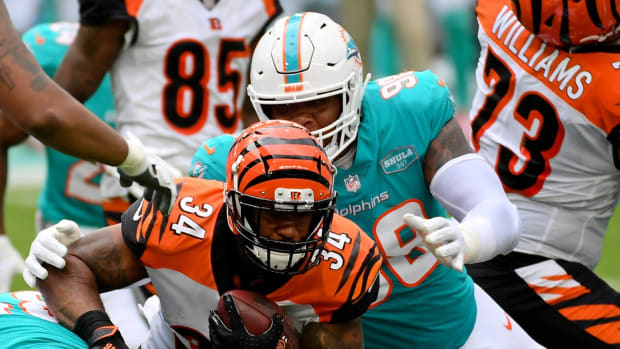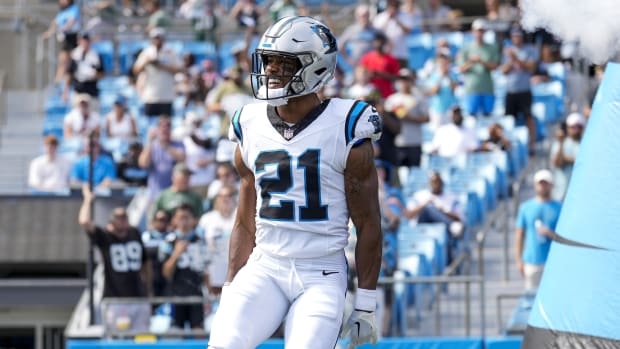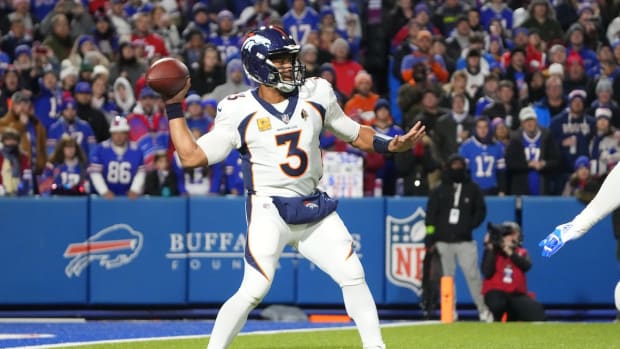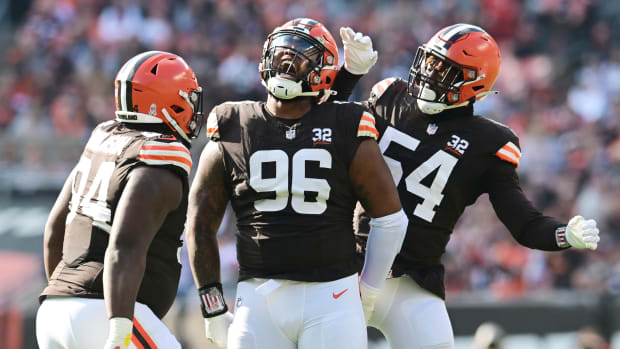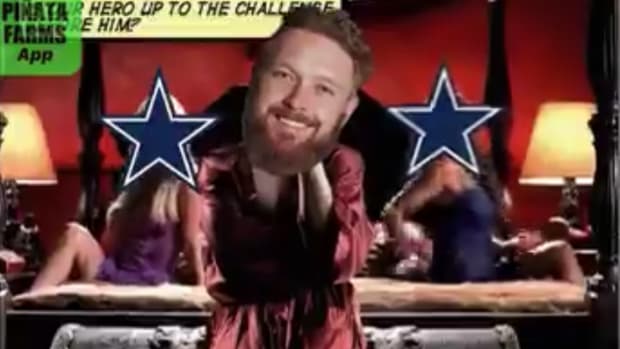Ryan Leaf lives with the regrets and lessons from his NFL draft experience
The spring of 1998 set the stage for one of the great pre-draft debates of all time: Ryan Leaf vs. Peyton Manning. In the lead-up to Round 1, the NFL community went back and forth on whether the strong-armed Leaf out of Washington State or the accomplished Manning from Tennessee should be the first player taken. After months of intrigue, Manning went No. 1 to the Colts and Leaf went No. 2 to the Chargers. Leaf started just 21 games before retiring in 2001. Many fans are also familiar with his rocky life after football, including a stint in the Montana state prison for burglary and drug possession after Leaf was caught breaking into homes to steal prescription painkillers.
Since his release in 2014, Leaf has worked as a program ambassador for Transcend, a sober living community in Los Angeles. In February, he was asked by the NFL to serve as a mentor for the quarterback prospects at the ’17 combine in Indianapolis, returning to the city that helped set the scene for his own draft drama. In an essay for SI, Leaf shares his experience working with young players and looks back at his own draft experience as a cautionary tale.
From the moment I arrived in Indianapolis, I couldn’t avoid my past. I ran into so many faces from my NFL career—former players, strength coaches, even the Chargers’ old capologist. It was an incredible honor to spend time with players like Deshaun Watson, Mitchell Trubisky, Patrick Mahomes and Davis Webb, and I was glad that I could help them navigate one of the most challenging stages of any prospect’s journey. But in doing so I was also forced to dredge up the failures of my own NFL career.
In Indy, I had an opportunity to look back on that time with understanding, not regret. I wanted to share some specific memories of my path to the 1998 draft to help put in perspective all that unfolded next in my career and in my life. Thanks to my experience in recovery, I can approach those memories with awareness and tools that help me turn them into a positive.
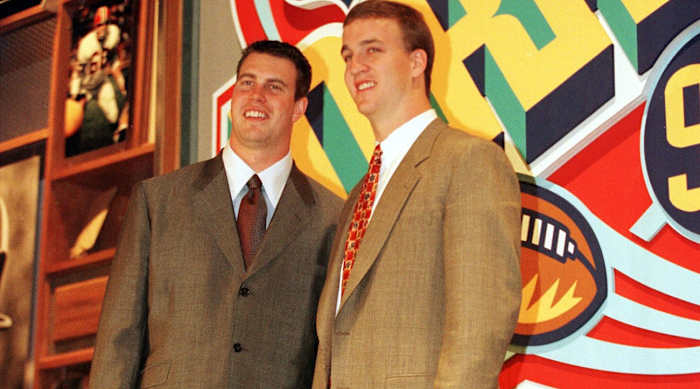
As the 1998 NFL draft approached, it became clear that Leaf (left) and Peyton Manning’s NFL careers would always be linked together.
Jamie Squire/Getty Images
As the draft approached, I knew I was going to be one of the top two picks. At No. 1, the Colts needed a quarterback, and then the Chargers traded a hefty ransom to the Cardinals (their 1998 first- and second-round picks, 1999 first-round pick, returner Eric Metcalf and linebacker Patrick Sapp) to move up one pick to the second spot. My mindset was, That’s right, you should trade up for me. I deserve to be picked that high and I deserve this attention.
I was very naïve and my ego had built up to toxic levels, a dangerous combination for a draft prospect. I didn’t think I needed to impress the teams—they needed to impress me, and they’d be lucky to have me. I even had this fantasy that I could choose where I wanted to play. One time I said to my agent Leigh Steinberg, “Let’s find a way to get me into a Steelers uniform because they were my team growing up.” Leigh offered to get me in touch with all of his future Hall of Fame clients: Troy Aikman, Steve Young, Drew Bledsoe. But I didn’t reach out. I had it covered.
I showed up to the combine overweight, out of shape and with the wrong attitude. Right around that time, a narrative emerged about me and the other top QB prospect, Peyton Manning. We did a photo shoot for ESPN the Magazine, and the poses they set up were telling. I was on the beach in a smoking jacket. Peyton was in a polo shirt looking like an All-American kid. I was cast as the guy wearing the black hat. Instead of nipping it in the bud, I embraced that image and let it affect my attitude. There’s nothing about being an outlaw or being flashy that makes you a better football player, but that wasn’t what I was thinking about at the time.
One combine incident that has been reported multiple times was that I intentionally skipped my interview with the Colts. It’s a little more complex than that. I missed the interview because the Bears asked to do an MRI of my thumb, which I had broken in high school. I was at the hospital when I should have been with the Colts. I’m not trying to take a high road here. Trust me, I felt completely inconvenienced by having to sit around the hospital for a non-existent injury. But missing my scheduled appointment was not premeditated—at least by me. The next day I heard Indy coach Jim Mora was furious. I was like, Screw you, if don’t want to draft me, I don’t want to play for you anyway.
After the combine, I went out to Newport Beach, Calif., and worked with a trainer. By the time my pro day rolled around, I was in great shape and ready to put on a show. Longtime NFL coach Marty Schottenheimer said it was the best pro day workout he’d seen since Troy Aikman. But you have to understand how I worked. I would only show something if I knew I could be the best at it. I did the vertical jump at the combine because I knew I would kill it. (I jumped 36 inches, by the way. I try to preach humility, but you have to admit, that’s pretty good for a country kid from Montana.)
• Think you can predict every Round 1 pick? Play the Peter King Mock Draft Challenge
Later on with the Chargers, I would only do drills I excelled at. If I thought I was going to be middle of the pack or worse, I just sat out. And that has a terrible effect on your team when the quarterback, who is supposed to be the leader, doesn’t participate. But before the draft, it was all a show. It wasn’t real. Yes, I could throw the ball and run and jump. That didn’t mean I understood the kind of work ethic needed to succeed in the NFL.
When I got to San Diego, I told reporters I was hoping for a 15-year career with a couple of parades downtown. I think that’s what a draft pick should say. I just didn’t understand what it took to achieve that. Instead of grabbing my playbook and getting to work, I immediately sought out a real estate agent to look at places. Then my Dad and I hopped on a commercial flight to meet friends in Las Vegas. I heard stories about Peyton holing himself up in the Colts’ facility for days when he arrived—and I’m off to Vegas to let people tell me how great I was.
I take full responsibility for how I handled that period of my career. My priorities at that time were out of whack. I had to leave Washington State early and be a top pick to show the world who I was. But it turns out none of the things I thought were important actually mattered.
I’ve thought about what I would say to myself if I could go back to that spring. First off, I would say, “Ryan, you don’t know s---. Just because you’re a good college football player does not mean that success will translate to the NFL. More importantly, just because you’re a good football player, doesn’t mean you’re a good person.” In my case, if I have empathy for other people, I work harder and I’m a better teammate. It’s a cliché, but football truly is a team sport. The coach and quarterback get the love, but the team needs to function as a cohesive unit.

Leaf made just 21 uninspiring starts in San Diego before retiring in 2001.
Patrick Murphy-Racey/Sports Illustrated/Getty Images
One of my biggest problems once I got to the NFL was getting along with my teammates. The criticism got me down—first the media, and then the guys on my team. It came off like I thought I was better than them because I made more money and I was a quarterback. I probably did think that. I should have attached myself to Junior Seau and Rodney Harrison from Day One and never left their side. But I decided to go my own way, and that never works.
I was excited to be a mentor at the combine so that I could apply the principles I’ve learned from my own personal recovery and my work for Transcend Recovery Community. This work has enabled me to look back with mindfulness. For so long I was driven by fear and ego—certainly during the draft process. The success stories I’m drawn to are from people who have been down and found a way to come back. Every day I’m inspired by my work, the people I’ve met in recovery and the people I’ve been able to reconnect with from my NFL life.
• Want more NFL draft intel? Check out Pro Football Focus's 2017 NFL Draft Pass
Nineteen years ago, I was drafted into a role that I had dreamed about my whole life. Two and a half years ago, when I was released from prison, my first job was driving the van for Transcend. It’s the greatest job I’ve ever had. I would have liked to advise a younger version of myself on the things I did wrong. But my journey has led me in another direction, and it is rewarding in a way I couldn’t have imagined.
From my personal experience, no matter if you’re the No. 2 pick or an undrafted free agent, your draft position doesn’t define you as a person or a player. I let that label define me in both positive and negative ways. But I’ve come to learn it was just a label—not the true measure of a player, and certainly not the true measure of a man.
































